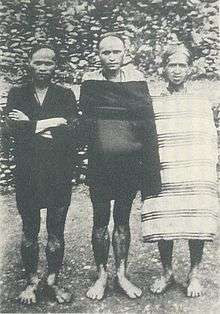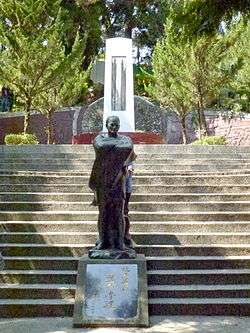Mona Rudao
| Mona Rudao | |
|---|---|
 Mona Rudao (centre) and Seediq other tribal leaders | |
| Born |
May 21, 1880 Formosa |
| Died |
July 1, 1930 (aged 50) Taichū Prefecture, Japanese Taiwan |
| Nationality | Seediq |
| Occupation | Chief of Mahebo |
| Children | 3 |
| Parent(s) | Luhe Rudao |
Mona Rudao, or Mouna Rudao (1880–1930) was the son of a chief of the Seediq tribe of Taiwanese aborigines. In 1911, he made a visit to Japan. He succeeded his father as a chief of the village of Mahebo (Chinese: 馬赫坡社) and became one of the most influential chiefs of the area of Wushe. Mona Rudao was from the Tgdaya group of the Seediq.

He became famous for orchestrating the revolt of Wushe in what is now Nantou County in 1930 against the Japanese authorities. He ended up committing suicide by shooting himself with a pistol during the revolt to prevent the Japanese from capturing him alive. His remains were found in a forest in 1933, and were taken to the Department of Archaeology of the Taihoku Imperial University where they were exhibited as a warning to future rebels. The bones were "identified" by his daughter and not positively confirmed by DNA. After the arrival of the Kuomintang the bones were placed in a warehouse until 1974 when they were reburied near the Kawanakajima (Japanese: 川中島, modern-day Alan-Gluban (Chinese: 清流部落)) tribe at the Wushe Incident Memorial Park. The Taiwanese viewed him as a hero for carrying out a revolt and he is now one of the figures on New Taiwan Dollar coins.
In 2005 the Kuomintang displayed a massive photo of Mona Rudao at its headquarters in honor of the 60th anniversary of Taiwan Retrocession Day.[1]
Mona Rudao has been part of Taiwanese popular culture, appearing in books and manga. His character took the part of protagonist in the 2003 TV Drama Dana Sakura (風中緋櫻) and the 2011 Taiwanese film Seediq Bale.
Information
Due to the oppression of Japanese officials, the prohibition of tattooing, and the loss of the "grass" tradition. On October 27, 1930, Mona Ludao led the ethnic revolution. When the revolution took place, the Governor was shocked. The Taiwanese Governor Shi Weiying immediately began military operations. He dispatched troops from the Taipei, Taichung, Tainan, and Hualien Harbor Halls to the Wushe Force. Major commander Min Yataka was appointed as the chief. Commander to carry out repression by force. On November 5, 1930, due to the heavy casualties of the Tainan Brigade of Japan, the Japanese side couldn't continue to attack it for a long time. It actually violated international conventions and airdropped "erosive gas bombs" (Louis gas bombs). Many aboriginal peoples were either killed or hanged themselves under giant trees. Under the embarrassment. At this time, Mona Ludao saw that any hope of success had already gone. He took his wife and two grandsons and ask them to hang themselves and then burned the bodies of three people. He himself went to the deep mountains and emptied himself in a secret cave with a three-eight rifle.
Footnotes
- ↑ 記者舞賽台北報導 (2005-10-26). "國民黨紀念光復稱莫那魯道抗日英雄". 台灣立報 lih pao.
See also
- (in English) Mona Rudao
- (in Chinese) Mona Rudao